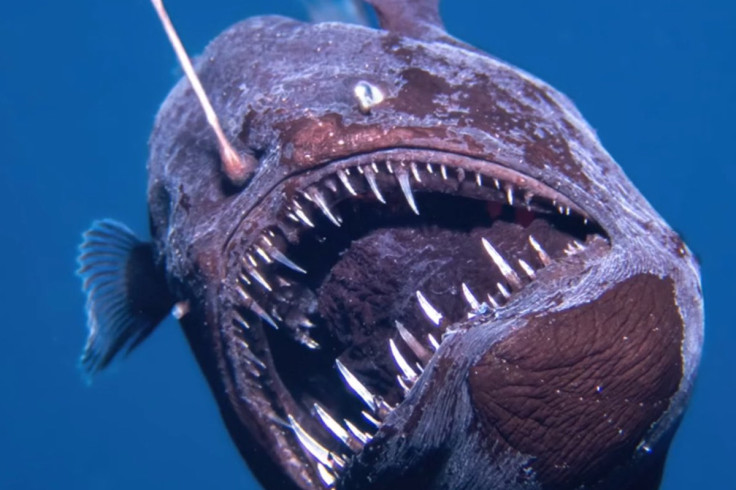Why Did The Deep Sea Anglerfish Rise Thousands of Feet in the Ocean? Scientists Baffled by Odd Behaviour – 'I Thought It Was AI!'
Thee creature is often referred to as a 'black sea monster.'

On 26th January 2025, a team of researchers off the Canary Islands made an extraordinary discovery: a black seadevil anglerfish, typically found in the extreme depths of the ocean, was spotted near the surface. This unprecedented sighting has left scientists astounded, as it marks only the second time this species has been recorded alive.
The black seadevil, Melanocetus johnsonii, is a rarely seen creature, often referred to as a 'black sea monster.' With its fearsome appearance, featuring sharp fangs and a bioluminescent lure, it has captured the imagination of many. However, experts stress that despite its terrifying look, the fish is 'mostly soft and squishy.'
Rare Photograph Captured
David Jara Bogunyà, a marine wildlife photographer, was aboard the research vessel Glaucus when the creature appeared. 'It was like a dream come true,' he says. 'When I was a child, I had a book with deep-sea creature illustrations. These animals looked so wild, they didn't seem real.' Yet, for over an hour, Jara and his team were able to swim alongside and capture this rare sighting of the black seadevil, a species that usually inhabits the inky depths of the ocean between 650 and 6,500 feet.
In the footage, the fish's distinctive features—its glowing lure, large teeth, and wide mouth—are clearly visible, adding to the excitement of the moment. 'When I first saw the video, I honestly didn't believe what I was seeing,' says Kory Evans, a fish biologist at Rice University. 'I thought it was AI.' This reaction was shared by many in the scientific community, as such close encounters with deep-sea creatures are exceedingly rare.
The only other recorded footage of a living black seadevil was captured in 2014, when marine scientists used a remotely operated vehicle to film the species at a depth of around 1,900 feet in Monterey Bay. This new discovery in the Canary Islands is therefore of immense significance.
@animalcrew.13 Angler Fish spotted swimming to the surface in broad daylight. It could be the first recorded sighting in the world of a living adult black seadevil or abyssal anglerfish, this species of anglerfish are found in the 'midnight zone' of the ocean around 2,000 metres below the surface... why do you think this is happing is it due to climate change I wonder 🤔 but isn't it just amazing getting to see such a beautiful creature ❤️🐟#fyp #boost #news #ocean #anglerfish #deepsea #sea #oceancreatures #deepseacreatures #hamstergang🐹 #animallover #properhamstercare #animals #trendingvideo #animalcrew13 #fyppp #fish #angler ♬ som original - WE ARE 00h.03m 🇨🇭
Why Did the Black Seadevil Swim to the Surface?
The behaviour of the black seadevil has raised numerous questions. Typically, these fish are ambush predators, spending most of their time remaining stationary in the deep sea, waiting for prey to approach. The sighting of this anglerfish swimming actively was particularly surprising.
Evans, who studies deep-sea creatures, explained that the black seadevil's behaviour was unexpected. 'Their whole strategy is not to move. They are ambush predators, just sitting there. So, seeing one swimming actively is quite shocking.'
There are several theories as to why the fish ventured so far from its usual habitat. One possibility is that the black seadevil consumed a fish with a swim bladder or gas gland, causing the gas to expand and potentially drawing the predator upwards. Another theory is that the fish was trapped in a column of warm water rising from volcanic activity in the area.
The Canary Islands are known for their undersea fissures, which could have affected the fish's movement. Alternatively, the black seadevil may have been carried to the surface after being preyed upon by a larger predator, such as a pilot whale or even a jellyfish, which then released it closer to the ocean's surface.
New Insights into the Deep Sea
While the black seadevil died shortly after the sighting, the brief moment in which it was alive provided valuable insights into this enigmatic species. 'These animals have been known for a long time, but we've mostly dealt with dead specimens,' says Bruce Robison, a senior scientist at the Monterey Bay Aquarium Research Institute, who recorded the first living black seadevil in 2014. 'What we've learned from past specimens is that they create their own light through a symbiotic relationship with bioluminescent bacteria.'
Anglerfish are also known for their unusual reproduction method, in which much smaller males fuse with females to provide genetic material. While it's unclear if the black seadevil follows the same process, this peculiar form of reproduction has fascinated scientists for years.
Though it is difficult to pinpoint exactly why the black seadevil made its journey to the surface, the encounter is a significant contribution to our understanding of the deep sea. 'The deep ocean is the largest habitat on Earth, and it's home to most of the creatures living on this planet,' Robison explains. 'We know so little about what's down there.'
This rare footage serves as a reminder of the vast and largely unexplored world beneath the ocean's surface. With each new discovery, we inch closer to unraveling the mysteries of the deep, offering a glimpse into an extraordinary realm that is as awe-inspiring as it is elusive.
© Copyright IBTimes 2025. All rights reserved.





















